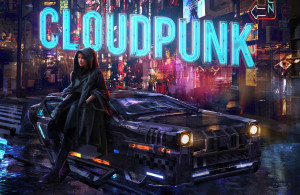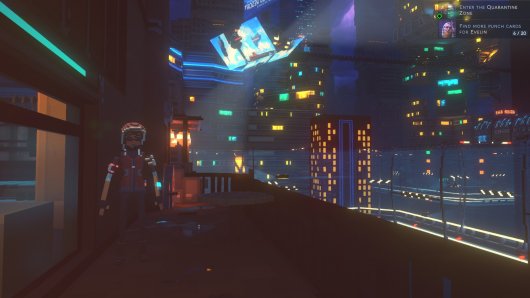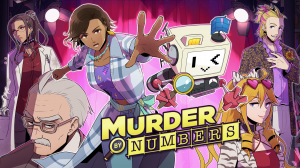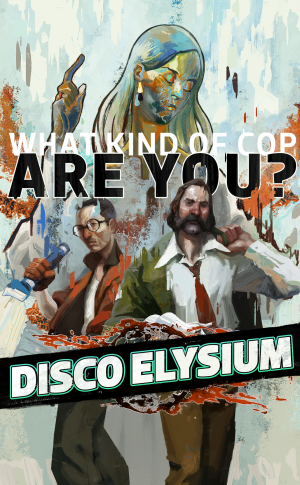Review for Cloudpunk
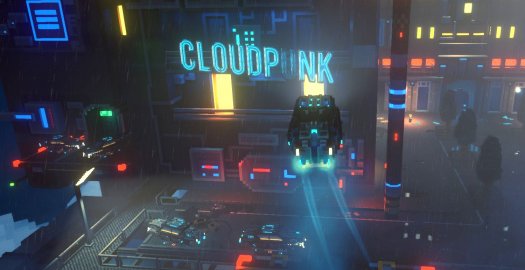
Nivalis, a futuristic metropolis born of Blade Runner, The Fifth Element, and any number of other science fiction influences, is a city of a thousand tales. Here a hovercraft driver for an illicit package delivery service named Rania begins her first night on the job, unaware that she’s about to be drawn into many of those stories all while following her own. And so too do players in ION LANDS’ 3D voxel-based adventure, Cloudpunk. With an entire city stretching “down 100 miles and up 1000” to roam both by air car and on foot, there’s a lot to see and do in Nivalis. Sometimes it’s funny, sometimes it’s touching, and sometimes it’s just downright bizarre, but other than being a little wordy at times, it’s always a lot of fun.
The protagonist is a young woman from the Eastern Peninsula just recently arrived in “the” big city. It’s generally believed Nivalis is the only metropolitan area left on earth. Whether that’s true or not is one of many discoveries Rania will make during her first shift working for the titular underground delivery service. The basic formula is that Cloudpunk Control, an elderly android, assigns Rania a pickup. She travels to that location in her HOVA – a Cloudpunk-issued air car – receives her parcel, then is given another destination to take the package to. In order to both retrieve and drop off her deliveries, Rania has to leave her HOVA in designated parking lots and then proceed on foot to the actual locations.
During her delivery runs, Rania frequently communicates with Control, her HOVA’s onboard artificial intelligence Camus, or occasionally other characters contacting her (presumably through some headset or implant, as she’s able to communicate with them outside the vehicle as well). Anyone Rania talks to, either in or out of the HOVA, has their portrait displayed in one corner of the screen while speaking. All conversations are conducted in linear fashion, with no branching trees or dialog choices available to players.
Camus is initially Rania’s only friend in the city. He is the simulated consciousness of a talking android dog Rania used to own. We soon discover that Rania’s life took a turn for the worse and she was forced to travel to Nivalis to earn money to pay her debts. Prior to that move she was a flutist, though now she finds no joy in playing and refuses to do so. Fortunately, she was able to bring Camus’s personality with her and install it as her HOVA’s automaton. Cloudpunk differentiates between automatons and androids. The difference is never explicitly made clear, but from context it seems that automatons are AI entities that don’t have autonomous bodies, while androids do have bodies.
In addition to her conversations with the crotchety Control and the naïve but always cheerful Camus, Rania frequently speaks with a large number of characters during her deliveries. Some are specific to her current assignment, while others are extras that she can run into on the street. The cast is quite varied, and fully voiced, with a healthy number of memorable characters. There’s the stuck-up William, an automaton and one of Rania’s first deliveries who is being dropped off, he thinks, to become a chef but really to be an apartment vacuum cleaner. Then there’s Mrs. Octavius Butler, a snooty woman who is prejudiced against everyone all the while claiming she’s not. Trying to make a living selling never-before-seen mechanical animals is the Falconer and his android falcon Norman, the former insisting there has never been an animal known as the falcon before, despite Rania having seen them herself before coming to the city. There’s also Comrade Bop, an android activist who has been reprogrammed by Corpsec, the security police force, to only be able to speak in rhyme, undercutting the message he would bring to the people. Rania also has a couple of run-ins with the nefarious BlockFourOh gang, whose way of “sticking it to the man” is through illegal urban renewal – creating playgrounds for children and the like.
Despite the apparent humorous side to the characters at first glance, many of them prove to be far deeper and darker. William arranges for a series of “accidents” to befall his superiors so he can take control of his apartment complex. A corporation staffed entirely by androids named Anderson has convinced them the outside world is a myth in order to keep them in perpetual slavery. Perhaps the most tragic tale centers around an android gumshoe named Huxley, who always speaks in bad ’30s noir detective metaphors, and a young android girl named Pashta, who is being turned over to the criminal element of the city by a certain Reoh of Corpsec to save Reoh’s own hide. Huxley is the focal point and comes and goes during Rania’s shift. While initially he seems comical and slightly annoying, as time goes on more is revealed about him and the others in his circle, culminating in several poignant and truly emotional moments.
There’s no one specific plot in Cloudpunk, as various characters and how they’re getting along are revisited throughout the game, either by coincidence or through additional assignments specifically involving the same people. However, if there was one storyline for Rania to call her own it, would be the one involving something called “CORA.” Not being a native of the city, Rania’s never heard the term before and her delving into what CORA is works well to enlighten the player as well. Some people in Nivalis think CORA is just a reference to fate or luck (e.g., thank CORA the decrepit buildings didn’t just fall on me!). Some think CORA stands for Computer Operated Recycling Agent, an old AI tasked with either running, or cleaning, or surveilling the city. Is CORA really a person? A machine? Something else entirely? Nobody seems to know the truth, but Rania is pulled into finding out more and more despite just wanting a quiet shift to make some Lims (cash).
Nivalis is quite immense, consisting of numerous zones connected by fast travel tunnels that are used to allow the next area to load. The city is very much inspired by Blade Runner, with its constantly pouring rain, large glowing billboards, frequent advertising announcements over speakers, and a vertical layering of traffic through different skylanes – virtual roads marked by intangible panels of glowing light (think the floating lines of traffic on Coruscant in the Star Wars prequel movies). While the traffic is organized in these floating “roads” between towering skyscrapers, players are not restricted to them. It’s actually easier and faster to get to a destination by leaving the roads for the open air and cutting through the city yourself, as none of game-controlled drivers do the same. In fact, Control even recommends finding more direct routes through the city than the grid.
Ironically, going off-road is actually safer as well. The roads are clogged with constantly moving traffic, which can be fun to watch but the simulated drivers are seemingly unaware of your presence if you go that way. They have no problem running into you if you’re not driving fast enough, or they’ll fail to slow down or move out of the way when you’re turning a corner. Getting hit by another vehicle or bumping into a building isn’t the end of the world, but your HOVA does start to get beat up and you may have to put in at a garage to get repairs or at a gas station in order to fuel up. Repairs are made instantaneously, while gassing up requires a brief wait until your HOVA’s tank is filled. In either case, you’ll need to spend some of the Lims you’ve earned from your deliveries. This sim-style element isn’t at all demanding, however, as I never had a money problem during the game.
Although the general aesthetic is one of dark buildings with bright lights below a sea of storm clouds, certain areas have their own distinct look and feel. Little Chinatown has many Asian influences with its paper lanterns and pagoda-shaped roofs. Some parts of the city are immensely dense, providing little opportunity to chart your own course and feeling very claustrophobic as a result. Other zones are much more sparse, allowing you to fly over and under and sometimes even through different structures. Then there’s the atmospheric undercity, the Marrow, where everything is shrouded in fog pierced only by distant lights and chimneys emitting flames. This stands in sharp contrast to the elite areas of Nivalis, high enough to be above the clouds, the only places where it doesn’t rain. I was really impressed by just how much is packed in to explore.
The HOVA can only be exited at designated parking spots. Doing so allows for the city to be explored on foot, which shows the voxel landscape a little closer up. Just as the sky is full of hovercars, the surface has a lot of pedestrian foot traffic, making the city feel alive, even at night. Except for a handful of interior locations, like Rania’s tiny one-room apartment, an abandoned theatre, and a night club with lighting that reminded me of Tron, walking around keeps you out in the same open parts of the city as driving. However, here you have to make use of elevators and suspended bridges to move from one block to another.
Self-directed exploration is definitely one of the funnest aspects of the game. Save for a handful of timed deliveries, there is no limit on how long you can take to complete a job. This leaves you free to drive or walk about Nivalis yourself to see everything it has to offer. A number of interesting characters and little side stories are only encountered if you head off the beaten trail and experience a slice of life of the city yourself. In one encounter, I ran into a disfigured android who needed a human to procure self-replicating flesh for him so he could venture out in public again. In another instance, Rania has an android neighbour Evelin who’s lost her memories and needs the Cloudpunk driver to search the city for punch cards that can help her recall who she was. These side missions are fun diversions and provide more background insight into the city’s goings-on, while usually also granting a monetary award.
While you won’t find anything in the way of puzzles to solve, wandering through the city, it’s possible to pick up a wide assortment of items. Some are just unimportant junk that can be sold to street vendors to help pay for gas or repairs or to buy any of the customizations that the merchants have available for Rania’s HOVA, apartment, or even her outfit, allowing for a nice degree of customization. At one point I even found a vendor who was selling ball gowns. Other attainable items are more important. Some, like the punch cards for Evelin, need to be delivered to specific characters. Others can be used to fix broken-down elevators or to get past Corpsec checkpoints to access parts of the city that otherwise aren’t connected to parking lots and so can’t be accessed by HOVA. I dabbled in quite a few of these side explorations, though not all of them by any means. Between the ones I tried and completing the main storyline, I sank a good ten enjoyable hours into Cloudpunk and I still want to go back and follow up on a few more optional side quests.
Occasionally the game presents jobs that offer a choice of options. For example, one pickup involves accepting the belongings of a person who’s fed up with living in the decaying city, so he’s lined up with other souls to take a great stairway that leads…to a long fall and frigid death in the ocean below. And he knows it! He gives Rania his worldly possessions. Cloudpunk wants the items to cover the man’s bill, but Rania also considers delivering them back to the man’s family. In these instances, separate waypoint markers are placed on the permanent in-game minimap that displays in a corner of the screen, and you will have the choice of which one to go to.
There aren’t a huge number of choices to make, but they add a welcome degree of player agency throughout the experience. That said, I never really got the feeling that my choices mattered all that much. There were a couple of times when Control cautioned me to make careful decisions, but I never had any bad consequences emerge. Unfortunately, I wasn’t easily able to test out how much difference other decisions might have made due to the fact that there is no manual save option, only a single progressive autosave, which was immensely disappointing.
Cloudpunk can be played with either a game controller or keyboard. I found the gamepad far preferable to the ordinal directions the WASD keys provide, particularly when flying through denser parts of the city where having a finer degree of control was helpful for steering around tightly packed buildings and other obstacles. While in the HOVA, the camera follows you around and you can accelerate and decelerate, turn left and right, and rise up or lower down. When flying low over a parking lot, the tap of a button automatically parks the craft and deposits Rania at the foot entrance to the lot. At ground level, the camera swings around Rania to provide new views as she wanders the city. In a couple of instances, the camera rotated 180 degrees on me so that Rania suddenly doubled back on the path she’d just taken. These spots required a bit of fiddly manipulation to get Rania moving in the desired direction, but fortunately they’re few and far between.
On the audio front, again Cloudpunk pulls from Blade Runner for much of its inspiration. In many parts of the city there are synthesized electronic tracks playing, especially when descending into the Marrow, where the accompaniment takes on a very foreboding and ominous tone. Rania herself sometimes tunes – without player input – into various radio frequencies in the city. Here she’s able to find some future pop-type music, though still with an electronic tinge, keeping the score from getting too repetitive. Sound effects are also well done, especially for the HOVA, which just sounds right to me, its engines giving a nice rumbly kick after you unlock the boosters and engage them. And, of course, there’s the constant subtle patter of the rain in the background.
Characters are consistently well voiced, with really no bad ones even with the sizeable number of different people encountered. Camus and a few others have some unfortunate breath pops, but these aren’t too distracting. The only character that really grated on me was Pashta. There is nothing wrong with the actress herself, but all android character voices have an electronic processing and it is especially pronounced with Pashta, such that I found it hard to understand what she was saying sometimes. (Thankfully the always-on subtitles make it easy to follow along.)
It’s good that the voices are generally so well done, as this game has a lot of unskippable talking. This is welcome when it plays over long drives from one part of the city to another, but briefly at times you’ll be in need of new instructions and have to wait for the current conversation to be finished first. As a result, with some conversations you just have to sit and listen while the characters yammer on. Overall, though, what they have to say is usually interesting and informative of their personalities.
With the HOVA allowing players to freely move through the massive city of Nivalis in three dimensions, vertically as well as horizontally, Cloudpunk offers a different spin on the environment exploration adventure. A wide array of characters all nicely performed with depth, humour, and pathos keeps things interesting throughout, and it’s fun to see how their lives progress as they’re encountered later on. While Rania’s backstory never comes into clear focus, she has enough personality to make her a solid protagonist as a stranger in a big city still trying to find her way. There’s nothing really here in the way of puzzles, but with the ability to explore such a vast and visually impressive futuristic metropolis, there’s a lot to admire. Who knew that just a single shift working for an illicit package delivery service in an open dystopian world could be so enticing?
WHERE CAN I DOWNLOAD Cloudpunk
Cloudpunk is available at:
We get a small commission from any game you buy through these links (except Steam).Our Verdict:
A huge city in a state of entropic decay to explore, a diverse and memorable cast to meet, and an engaging new spin on adventure game navigation make for a highly compelling sci-fi experience in Cloudpunk.


